Recent Comments
No comments to show.
Our goal here at Rockabye Baby Hire has always been to provide our customers with the most up to date information, products and resources to empower you to make informed decisions for your families.
You may be getting ready to return your hired capsule or carseat and that means you will be doing some carseat shopping. Our guide has been put together by our Accredited Restraint Fitting Team to help you navigate the choices, options and products that are on offer and help you to choose the right seat for your child, your needs and your budget.
When we arrive at a baby shop, instinctively we will gravitate to either a label or logo we recognise, or a colour we like. However choosing the correct product for your child is much more complex than that. We have set out our top tips as well as information on available products below for you. Of course this list is not exhaustive but we have done our best to be as comprehensive as possible. As always, if you need our help we are just a phone call away.
Ensure that the seat you are considering is the right size for your child and that it meets Australian Standards and has the Australian Standards logo sticker present. Contrary to popular belief, Australian Standards for car seats are in fact among the toughest in the world ensuring the best possible protection for our children on the road.
In Australia it is illegal to purchase or use a car seat that does not comply with the Australian/New Zealand Standard 1754 – even if you are visiting. Always look for the certification mark AS/NZS:1754 on the car seat you choose for your child.
Seats are not graded by age of children but by their size. The size of children can vary – two 4 year olds can be entirely different heights and weights so check that your childs fits within the shoulder height marker label for the specific model of car seat you are considering. Just like when you are buying jeans – you take your legs with you to ensure the product fits so take your child with you to test the restraint does in fact fit them.
Is it easy to use?
You’ll be using this seat a lot. Is it easy for you to use? When you go to the hire company or the baby shop ask them to put the restraint on your backseat in the position it will be fitted in. How easy is it for you to get your child in and out of this restraint?
Is it easy to adjust?
We also suggest you test the adjustment mechanisms on the inbuilt harness – do they loosen and tighten easily? And when its time to adjust the shoulder strap height up a new level can you do that from the front of the seat or do you have to completely uninstall it, adjust them then try and reinstall it each time?
Is it affordable?
Price is not a great indicator for quality – and that is a good thing. There is something available for most budgets on the market today. Do not feel like you are a bad parent or being cheap if you can not afford $700 for a carseat. The biggest price tag does not ensure you have the safest seat. Have a look at the CREP results. The Child Restraint Evaluation Program (CREP) is a consortium of government agencies and motorist organisations whose aim it is to provide independent and consistent information on the levels of child protection from injury in a crash provided by individual car seats and the ease with which they can be used correctly using a very simple star system with 1 out of 5 being the lowest score and 5 out of 5 the highest.
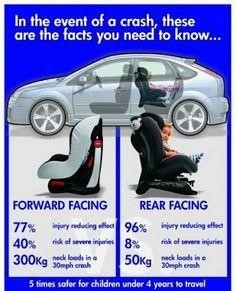
How long can you use this carseat for? Try and find a restraint with the highest shoulder height markers for ending use so you can use the seat for a long period of time. If you hope to keep your child rear facing then an extended rear facing seat with a tall shoulder height marker will be idea for you. Or maybe consider getting one of the new Type G restraints – these use the inbuilt harness up to an average 8 year old meaning you do not won’t ever have to buy a booster seat.
The road laws relating to kids and cars are minimums. We do not aim for the minimum safety – but for the maximum. So keep your child in their restraint for as long as they still fit in it. When your child reaches 6 months that does not mean its time to turn them forward facing. Just because they turn 3 you do not put them in size 3 shoes – if theseat still fits – keep using it.
Use their age as a guide only.
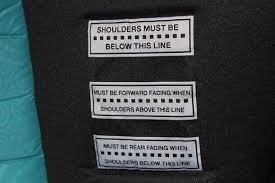
Newer seats nowadays all have a label on the restraint showing you exactly where the childs shoulders can be to safely use the seat. Shoulder height markers make it so easy for parents and carers to establish if a child car seat is suitable for their child and when the child needs to have the shoulder straps adjusted or when they are ready to move to the next child car seat.
Shoulder Height Markers, located on the inner side of the seat, prompt parents and carers to ensure their childs seats, and associated harnesses, are adjusted at the right stages of the childs growth to maintain optimal safety in the event of an accident.
Your child should remain in a rear facing seat or position until their shoulder is in-line or above the forward facing height marker.
Your child should remain in a forward facing seat until their shoulder height is above the upper shoulder height marker.
Note: There is a slight difference between rear and forward facing and that relates to the dynamics in the event of a collision.
We do not necessarily believe that you require professional installation of your restraint however there are a lot of belts, buckles and pathways to contend with. Before you begin, ensure you have read the instruction manual for your restraint in full and be confident that you understand how to install your seat. If you are uncertain please do not hesitate to contact us or a local restraint fitting station for advice. Unfortunately there is a lack of understanding around the power of collision dynamics and there is an idea in the community that a car seat must be ‘rock solid’ postfitment to be safe. This is incorrect. The Australian Standard testing procedures that these products are subjected to are stringent and demanding.
The more rigidly a restraint is attached to the vehicle chassis, the more collision force the infant will be subject to. Imagine if you will the catching arm of a cricket player. If it were completely rigid and unmoving it would shatter into pieces – exactly the same with carseats. Even the new rigid ISOFIX seats have a hinge that allow for some up and down movement to counter this possibility.
Overtensioning a restraint when installing it can cause stress damage to both the restraint and/or the vehicle seats unecessarily. A restraint that is fitted correctly does allow for some movement but no more than 2.5 cms from side to side at the belt path end of the restraint. Shaking your restraint around at the top end (where the top tether begins) is not an accurate test of correct fitment and will do nothing but loosen your restraint and perhaps leave the seat requiring refitment.
We have had customers return capsules or carseats and inform us that they didn’t use the top tether because it was annoying or took up too much time to deal with.
Please – use the top tether. In an accident it serves as a very important tool to minimise the possibility of yourchild being injured in the crash.
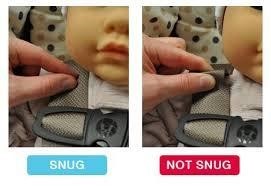
When you are using the inbuilt harness ensure that the shoulder straps are:
We hope that keeping our list of tips and information in mind will help you to make the right choice. If you have any concerns about child car seat use or how to choose please do not hesitate to contact our Team on 1300 859 775 who will be very happy to assist you.
Kind regards
Rock-A-Bye Baby Equipment Hire
Sydney’s Favorite Hire Company Ph: 1300 859 775 https://www.rockabyebabyhire.com.au
Posted by admin in Explore Sydney, General, How to on March 8th, 2019
Going on a family holiday? It is such an exciting time, being able to make memories with your kids and provide them with a fun few days or weeks away from home right? Well yes, the holiday itself will be exciting however as a parent who is about to go on a long drive with a car full of kids you are probably stressing, dreading and thinking why the earth did I decide to do this. Don’t stress too much, there are ways that you can make the car trip that little bit simpler on everyone.
Before piling everyone into the car, make sure that your car seats and boosters are all properly secured into their spots and are restrained. This is the most important step to ensure that everyone is safe and secure throughout the drive. When stopping for rest breaks, check the buckles before putting the kids back in to make sure that their little hands have not been playing around and unplugged anything.
When going on a road trip there is going to be a lot of packing needing to be done. Not only for the actual holiday but there is also things that you need to have packed and in reach or handy locations in the car for during the trip. Try to pack as much of the car as possible the night before to avoid having to pack the morning of the trip when you have little eager children waiting to leave. Try to pack as minimal as possible, especially if you are going to be spending a few days in the car.
The last thing you want is for the kids to be in the back of the car complaining that they are uncomfortable. This is going to make the trip seem WAY longer! Where possible equip them with little blankets and cushions to help them stay comfortable
Keeping the kids occupied throughout the trip will help save the sanity of everyone in the car. Putting together little activity packs for each child will help to keep them occupied and distracted throughout the drive. Colouring in books, reading books, figurines and dvds will help during the drive. Also don’t forget the snacks! Cut up fruit, biscuits, chips and sandwiches are all foods that are relatively low mess foods that should be okay to snack on whilst driving.
Choosing an ideal time to leave will depend on a few different things including; how far you are needing to drive, the age of your kids and the route in which you are taking. Where possible try to leave either late at night or very early in the morning if you are doing a long drive. This means that you may get a couple of hours of your little ones sleeping and will make the trip seem like it is going a lot quicker.
Travelling with kids does not need to be a stressful affair and with these few little tips you just may make it out alive ?
Happy travelling and if you have any other tips that may help feel free to share them!
Posted by admin in General, How to, Maternal Health, Pregnancy on March 8th, 2019
It is an exciting moment when you are your partner decide that it is time to start trying for a baby. Bringing a new life into the world is an amazing thing and the feelings that you start to have once you become a parent are ones you never knew were possible. For some people falling pregnant can be very quick and easy and others it may take some time to happen. There is no need to stress if it does not happen the first time you have unprotected sex, there are many factors that can contribute to why you have not fallen pregnant. There are things that you can also do to help to increase your chances of falling pregnant.

Unfortunately you can not just fall pregnant at any time, although how handy would that be! In order to fall pregnant the released egg must be fertilized by the sperm within 24 hours of being released. This means that there is a small window each month in which you can get pregnant. Your egg is typically released around 14 days before the first day of your next period which means that having intercourse a day or so before this and when the egg is being released is the ideal timing.
If you do not have a regular 28 day cycle and are unsure on when you are ovulating you can track your ovulation in a couple of ways including tracking your temperature, vaginal discharge or by purchasing an ovulation tracking kit.
Your lifestyle can play a part in falling pregnant. It is recommended to try to live a healthy lifestyle whilst trying to fall pregnant. This can include ensuring that you are getting an adequate amount of exercise, eating a healthy diet and not taking part in activities such as binge drinking and illegal drug use.
When choosing your foods for your healthy eating ensure that you are eating goods packed with food nutrients such as leafy greens, good amounts of protein and lots of fresh plant based foods. Try to avoid fatty foods and caffeinated drinks.
Exercising to keep your weight down and your body fit is a good idea however try not to take part in too many strenuous activities. Completing too much strenuous exercise can alter your periods which means that your ovulation dates can change which can then throw off your whole tracking.
When you decide that you are going to begin trying for a baby it is a good idea to start starting prenatal vitamins. These vitamins are full of goodness that will not only help you and your body but also help the progression of the pregnancy and health of the fetus once you fall pregnant. When you find out you are pregnant you are normally a few weeks in already which means that there has been time where you did not know you were pregnant, starting the vitamins whilst you are trying means that you have covered the new baby during those first few weeks
As hard as it may sound, it is best to try not too stress too much. You may be stressing about the falling pregnant or stressing about other things in your life at the time. Stress can play a lot of havoc on your mind and your body and too much stress can also lead to reduced periods or your periods becoming irregular. Maintaining a regular period means that you will be able to track your ovulation a lot easier and not be confused about when your ideal window is.
If at any point you think that there may be something wrong or you have been trying to fall pregnant for a while without success, put your mind at ease and visit your doctor. They would be happy to speak with you about what you have tried, complete testing if necessary and provide help and assistance where they can.
Remember as well, just because there is an ideal window, doesn’t mean that you can not ‘practice’ through out the month ?
Posted by admin in Babies 6 months - 4 years, General, How to, Safety, Travelling with kids on October 13th, 2017
Our goal has always been to provide our customers with the most up to date information, products and resources to empower you to make informed decisions for your families.
You may be getting ready to return your hired capsule or carseat and that means you will be doing some carseat shopping. Our guide has been put together by our Accredited Restraint Fitting Team to help you navigate the choices, options and products that are on offer and help you to choose the right seat for your child, your needs and your budget.
When we arrive at a baby shop, instinctively we will gravitate to either a label or logo we recognise, or a colour we like. However choosing the correct product for your child is much more complex than that. We have set out our top tips as well as information on available products below for you. Of course this list is not exhaustive but we have done our best to be as comprehensive as possible. As always, if you need our help we are just a phone call away.
Ensure that the seat you are considering is the right size for your child and that it meets Australian Standards and has the Australian Standards logo sticker present.
Contrary to popular belief, Australian Standards for car seats are in fact among the toughest in the world ensuring the best possible protection for our children on the road.
In Australia it is illegal to purchase or use a car seat that does not comply with the Australian/New Zealand Standard 1754 – even if you are visiting. Always look for the certification mark AS/NZS:1754 on the car seat you choose for your child.
Seats are not graded by age of children but by their size. The size of children can vary – two 4 year olds can be entirely different heights and weights so check that your childs fits within the shoulder height marker label for the specific model of car seat you are considering. Just like when you are buying jeans – you take your legs with you to ensure the product fits so take your child with you to test the restraint does in fact fit them.
Is it easy to use?
You’ll be using this seat a lot. Is it easy for you to use? When you go to the hire company or the baby shop ask them to put the restraint on your backseat in the position it will be fitted in. How easy is it for you to get your child in and out of this restraint?
Is it easy to adjust?
We also suggest you test the adjustment mechanisms on the inbuilt harness – do they loosen and tighten easily? And when its time to adjust the shoulder strap height up a new level can you do that from the front of the seat or do you have to completely uninstall it, adjust them then try and reinstall it each time?
Is it affordable?
Price is not a great indicator for quality – and that is a good thing. There is something available for most budgets on the market today. Do not feel like you are a bad parent or being cheap if you can not afford $700 for a carseat. The biggest price tag does not ensure you have the safest seat. Have a look at the CREP results. The Child Restraint Evaluation Program (CREP) is a consortium of government agencies and motorist organisations whose aim it is to provide independent and consistent information on the levels of child protection from injury in a crash provided by individual car seats and the ease with which they can be used correctly using a very simple star system with 1 out of 5 being the lowest score and 5 out of 5 the highest.
www.childcarseats.com.au
How long can you use this carseat for? Try and find a restraint with the highest shoulder height markers for ending use so you can use the seat for a long period of time. If you hope to keep your child rear facing then an extended rear facing seat with a tall shoulder height marker will be idea for you. Or maybe consider getting one of the new Type G restraints – these use the inbuilt harness up to an average 8 year old meaning you do not won’t ever have to buy a booster seat.
The road laws relating to kids and cars are minimums. We do not aim for the minimum safety – but for the maximum. So keep your child in their restraint for as long as they still fit in it. When your child reaches 6 months that does not mean its time to turn them forward facing. Just because they turn 3 you do not put them in size 3 shoes – if the seat still fits – keep using it.
Use their age as a guide only:
Newer seats nowadays all have a label on the restraint showing you exactly where the childs shoulders can be to safely use the seat. Shoulder height markers make it so easy for parents and carers to establish if a child car seat is suitable for their child and when the child needs to have the shoulder straps adjusted or when they are ready to move to the next child car seat.
Shoulder Height Markers, located on the inner side of the seat, prompt parents and carers to ensure their childs seats, and associated harnesses, are adjusted at the right stages of the childs growth to maintain optimal safety in the event of an accident.
Your child should remain in a rear facing seat or position until their shoulder is in-line or above the forward facing height marker.
Your child should remain in a forward facing seat until their shoulder height is above the upper shoulder height marker.
Note: There is a slight difference between rear and forward facing and that relates to the dynamics in the event of a collision.
We do not necessarily believe that you require professional installation of your restraint however there are a lot of belts, buckles and pathways to contend with. Before you begin, ensure you have read the instruction manual for your restraint in full and be confident that you understand how to install your seat. If you are uncertain please do not hesitate to contact us or a local restraint fitting station for advice.
Unfortunately there is a lack of understanding around the power of collision dynamics and there is an idea in the community that a car seat must be ‘rock solid’ post-fitment to be safe. This is incorrect. The Australian Standard testing procedures that these products are subjected to are stringent and demanding.
The more rigidly a restraint is attached to the vehicle chassis, the more collision force the infant will be subject to. Imagine if you will the catching arm of a cricket player. If it were completely rigid and unmoving it would shatter into pieces – exactly the same with carseats. Even the new rigid ISOFIX seats have a hinge that allow for some up and down movement to counter this possibility.
Overtensioning a restraint when installing it can cause stress damage to both the restraint and/or the vehicle seats unecessarily. A restraint that is fitted correctly does allow for some movement but no more than 2.5 cms from side to side at the belt path end of the restraint. Shaking your restraint around at the top end (where the top tether begins) is not an accurate test of correct fitment and will do nothing but loosen your restraint and perhaps leave the seat requiring refitment.
We have had customers return capsules or carseats and inform us that they didn’t use the top tether because it was annoying or took up too much time to deal with. Please – use the top tether. In an accident it serves as a very important tool to minimise the possibility of your child being injured in the crash.
When you are using the inbuilt harness ensure that the shoulder straps are:
Pinch test
Our retail arm has a selection of the latest, age appropriate current standard seats for sale including rear facing, forward facing, extended use seats and ISOFIX models. We can assist you to choose the right seat for your family. You can order and buy a seat from us and we will deliver it, pick up your hired restraint and install the new one all at the same time at no extra cost.
https://www.rockabyebabyhire.com.au/shop/category/carseats/
We hope that keeping our list of tips and information in mind will help you to make the right choice. If you have any concerns about child car seat use or how to choose please do not hesitate to contact our Team on 1300 859 775 who will be very happy to assist you.
Posted by admin in Babies 0-6 months, General, How to, Safety, Travelling with kids on June 9th, 2017
As your baby grows it is important to check and, where necessary, adjust the inbuilt harness in your hire baby seat.
Your capsule would have been provided to you on its lowest (newborn) setting with the shoulder harness on the very bottom option. Week by week, new babies put on weight and grow in length and this will mean that from time to time you will have to move the shoulder straps up a level to ensure your baby enjoys optimum safety in their hire capsule.
Harness straps that are too low for baby’s height or are twisted can be the cause of very serious injury in the event of an accident so ensuring that the shoulder harness straps are flat, firmly fitted and at the right level for your baby is vitally important.
We invite you to view our instructional video that shows how quick and simple it is to adjust the shoulder straps in your baby seat:
Posted by admin in Babies 0-6 months, General, How to, Safety on May 8th, 2017
Bathing a newborn baby for the first time often brings out feelings of anxiety in new parents. As a former NICU/Special Care Nurse, I saw this all the time. The practice of post-natal midwives and nurses should be: show one, assist one then supervise one. Unfortunately, this doesn’t always happen for various reasons so I have a step-by-step guide as well as some dos and don’ts as a general reference. However, please make sure you follow any advice or instructions given to you by health care professionals over this information.
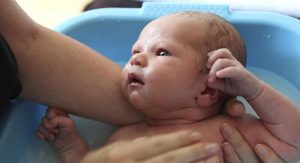
It is important to remember that babies needs and wants vary. Especially when it comes to things like sleep patterns, likes and dislikes. We often think babies hate baths but the fact is most of them find it relaxing and enjoyable. The part they don’t like is the undressing and then removal from the nice warm water. Once in that warm water the crying can often stop and the baby will look and feel contented. That’s why it is best to bath baby in the evening just before their evening feed then bedtime. It will take some time to work out your baby’s routines so use the evening as guide at first and choose a time when you will be less likely to have distractions.
Something I always advocate is minimal use of soaps and especially bubble bath. It might make you feel good to clean you baby with something sudsy as that is what we think cleans the best. The fact is, babies don’t need suds and their fragile skin can be made even drier because of them. You know what it’s like having dry, flaky skin and scratching, feeling uncomfortable. Imagine how uncomfortable that would feel if you were a tiny baby not capable of scratching! Also avoid scented creams and lotions. If your baby has dry skin then a little sorbolene or zinc and castor oil is very good and a lovely way to gently massage them at the same time. This is a great relaxation technique.
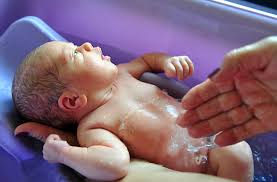
Posted by admin in Babies 0-6 months, Babies 6 months - 4 years, General, How to, Safety on March 20th, 2017
We do a lot of installing of carseats and capsules round here. Approximately 3 or 4 dozen a week, rising to double that during peak periods. We work very hard to ensure that our fittings always exceed the manufacturer’s instructions and do our best to teach our customers how to safely use their restraint once they leave our premises.
The one issue that seems to arise quite often is whether or not the seat is installed “tightly enough”. There is a perception in the community that a carseat or baby capsule has to be “rock solid” to be safe and that any movement at all is a sign of poor workmanship, incorrect fitment and/or dangerous for the infant. Parents will “test” their child restraint by shaking or pushing it from side to side, and when it moves panic sets in.
A restraint that has a firm relationship to the vehicle is preferred, but this aspect is often taken way too far, with some customers ‘testing’ their fitting by shaking the restraint to prove it’s ‘safety level’. The engineering reality is that nothing that is to survive extreme forces is designed to be rigid. Everything is designed to flex. We do not catch a cricket ball with rigid arm, otherwise we would have a cricket team with multiple broken bones in their arms. The more rigidly a child restraint is attached to the chassis of the vehicle the more force the passenger will have to cope with. This is one ‘perceived benefit’ that attracts consumers to ISOFIX products, thinking that its a tighter = better fitment. Its important to note that seatbelt webbings and mountings exceed the strength of ISOFIX fittings so if your car or restraint doesn’t have ISOFIX you’re not missing out on anything in the safety department.
As long as your capsule or carseat doesn’t move more than about 1.5 cms at the belt path end (ie. where the seatbelt or isofix points are attached) then it is fine. Some movement in some circumstances is perfectly fine. Pushing, shaking or rocking the restraint does nothing and is not an adequate test of correct fitment.
All restraints under the Australian Standard are tested stringently and any restraint installed to the manufacturer’s instructions and used properly each and every trip will keep your baby safe in an accident.
If you have any questions or concerns about your restraint please don’t hesitate to contact our Restraint Fitting Team on 1300859775.
There are seven different types of child restraints under the latest mandatory standard (Australian and New Zealand Standard AS/NZS 1754). This new standard came into effect on 19 September 2014.
The laws in Australia relating to kids and cars are now age rather than height or weight based.
We strongly recommend that parents continue to use each restraint until their child outgrows it. So if your 13 month old baby still fits comfortably in their baby capsule then by all means continue to use that until she has outgrown it. While the law specifies the minimum, it’s safest to only move your child to the next type of restraint only once they outgrow their current restraint.
Rearward facing restraints are safest for infants under 4 years of age. In fact, even as adults in even minor accidents, major damage can be inflicted on our spines and neck. However, having adults driving rearward facing is just not possible. The head of an infant makes up 25% of their body weight, compared to the head of an adult which is only 6% of our body weight. In a full frontal collision, everything is forced forward so in a forward facing restraint, although the child’s torso and legs are held back by the harness in their car restraint, their head will hit their chest and then fly back again leaving them at significant risk of neck and spinal injury or in the worst case scenario, internal decapitation. In a rear facing restraint, a child will slide back up into their restraint quite safely with their head, neck, back and torso all moving together in a straight line completely avoiding the whiplash motion that occurs when a child faces forward. Rear facing beyond 6 months (sometimes called extended rear facing) is practised in many countries with undeniably positive safety results. In Sweden children have been remaining rear facing until 4 years for nearly 50 years and they have a nearly zero fatality rate each year.
I strongly recommend you keep your child rear facing until they reach the rear-facing limits of their convertible seat. With most modern seats that will happen from around 18 months old to 2 years plus. Turning from rear or forward facing is not a milestone that you should be rushing to meet. Forward facing is far more dangerous full stop. Once your child outgrows their baby capsule or baby carseat (which are always rear facing) then you’re ready to move them to a convertible carseat. There are plenty of seats on the market that allow extended rear facing
Posted by admin in Babies 0-6 months, Babies 6 months - 4 years, General, How to, Safety on March 27th, 2016
There is a lot to consider when choosing a car restraint for your new baby. With all the products on offer, the shiny colourful products and the pushy salespeople it can feel overwhelming. We’re often asked what should parents look out for when buying a new car seat/capsule etc? What features are important? What safety certification should they have? Our guide to choosing the right baby carseat or capsule will hopefully help you to make the right choice.
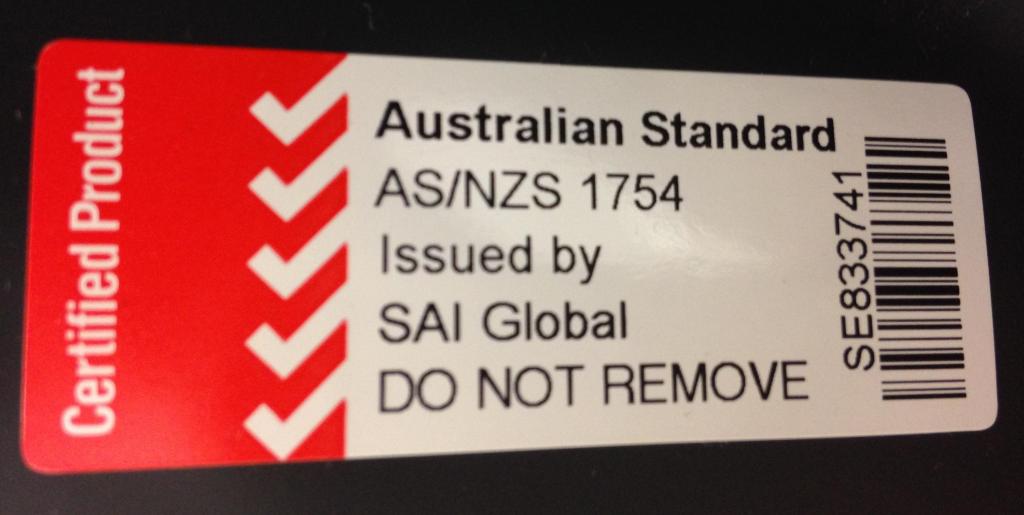
What to look for:
A booster seat is an additional seat that sits on top of the carseat to lift the child up several centimetres to avoid them being injured in the neck area by the car seatbelt. Booster seats should be used once a child no longer fits into their forward facing restraint as indicated by the shoulder height markers (and not just because they’ve celebrated their 4th birthday). There are two types of booster seats available on the Australian market. The first is a dedicated booster seat with a back. This type of booster uses the car lap/sash seatbelt to secure the child; the other is a convertible restraint that converts from a harnessed carseat into a booster once the child reaches the appropriate shoulder height marker within the restraint.
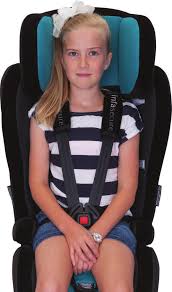
The new Type G restraints available here to hire or brand new seats to buy have an inbuilt harness suitable for children up to about 8 years of age.
Booster cushions (the little bottom only cushions that have no back, sides, head or tether) were deleted from the 2010 Australian child restraint standard and are no longer manufactured. They are however still used and are often seen for sale on the second hand market. I would not recommend you use one of these cushions due to the fact that they offer no side or head protection at all in a collision and could leave your child vulnerable to serious injury. The decision regarding when to move your child out of a booster is one that has confused many parents.
There is, however, a very simple 5-step test that can assist you to make the right decision. Seat your child in the car without the booster and buckle them up in the car seatbelt. Now answer these 5 questions:
If you’ve answered yes to all of those questions (and your child is over 7 and has outgrown their current restraint) then your child is ok to ride in the car without a booster.